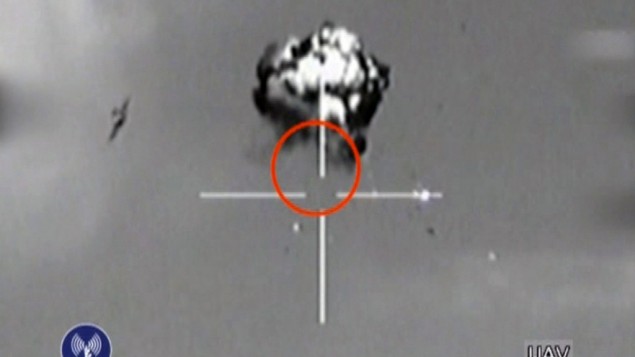Sheikh Hassan Nasrallah, the leader of Hezbollah told the militant movement’s al-Manar television network that his group was behind the launch of a mysterious UAV (unmanned aerial vehicle) shot down over Israel last week.Israeli Air Force F-16 fighter jets were scrambled to intercept the spy drone (a remotely piloted helicopter), and shot it down over the Negev desert.
According to Nasrallah, the UAV was assembled in Lebanon but made in Iran, thus officially confirming Tehran’s support to Hezbollah. Iranian UAVs operated by Assadists have been constantly spotted over Syria, spying on rebels, since the beginning of the uprising.
After an initial investigation, Israeli officials had already discovered that the drone was launched from Lebanon, and flew along the coast before managing to reach Negev. According to an al-Arabiya report, the spy drone was able to capture imagery from Israel’s nuclear facility in Dimona but Israel reports suggested the drone was relatively primitive and unable to transmit real time footage of the target to its ground control station over long range.
Advanced or not, the drone was able to violate one of the most very well guarded airspaces in the world, possibly covering a distance of about 300 kilometers before being shot down: since its range exceeded 200 km, more than a tactical drone, it should be considered a real MALE (Medium Altitude Long Endurance). Not a Predator, still an interesting piece of hardware, that could have been launched from a ship (to shorten the “trip” and make the UAV more difficult to spot on departure).
According to the information provided by Israeli media outlets, radar stations detected the UAV when it was flying parallel to the coastline southbound from Lebanon. As said, two F-16s were scrambled to intercept the Slow Mover: they trailed the intruder for some 30 minutes before hitting the target as it was flying north of Beersheba.
Quite interestingly, the F-16 did not hit the drone on the first attempt: the Python IV missile launched by the Israeli plane missed the plane. Hence, the one that did destroy it, was a second air-to-air missile.
This might explain why the pilot flew so close to the target (you can clearly see the fighter jet taking an evasive maneuver after the UAV explodes), almost entering the so-called “frag envelope” (mainly used to describe the explosive pattern of an air-to-ground weapon): maybe he fired the second missile in close proximity, to be sure the Python hit the drone.
The Python is considered as one of the most advanced missiles in the world, with superior performance and maneuverability.
Reportedly, this was the first time the IAF missed hitting an enemy drone.The drone was small sized, with a small IR signature, hence more difficult to hit. But it was being tracked from minutes and it was flying at slow speed, meaning that it was a relatively easy shot.
The IAF said an investigation into the incident would be launched (although the findings would not be made public).
Image credit: Rafael
Top: screen dump of the footage released by the IDF: the F-16 can be seen on the left.
Related Articles
- Israeli Air Force releases video of mysterious drone shot down by an F-16 over Israeli airspace (theaviationist.com)
- Israeli Air Force flies mock air raids over Lebanon in response to the mysterious UAV violation of Israeli airspace (theaviationist.com)
- New images of the mystery bird-like drone crashed in Pakistan. Taken in Iraq. (theaviationist.com)
- Did Israel Hack Unmanned Helicopter that Entered it’s Airspace? (cyberarms.wordpress.com)








